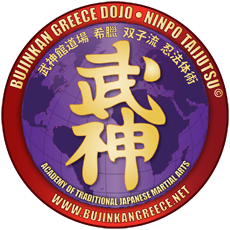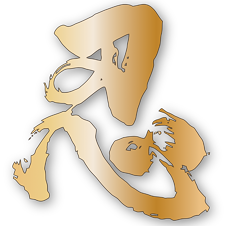Jutte - Kabutowari - Tessen - Sensu
十手 。 兜割 。 鉄扇 。 扇子
Jutte - Kabutowari - Tessen - Sensu

- jutte (十手) or Jitte, literally meaning “ten-hand” (i.e., the weapon with the power of ten hands), is a specialized weapon. Juttejutsu was evolved mainly for the law enforcement officers of the Edo period to enable non-lethal disarmament and apprehension of criminals who were usually carrying a sword. Besides the use of striking an assailant on the head, wrists, hands and arms like that of a baton, the jitte can also be used for blocking, deflecting and grappling a sword in the hands of a skilled user.
Bujinkan Baton fighting, is a baton weapon for self defence. In Edo period Japan the Jutte was a substitute for a badge and represented someone on official business and was carried by all levels of police officers including high ranking Samurai police officials and low-rank samurai law enforcement officers (called Okappiki or Doshin). Other high ranking samurai officials carried a Jutte as a badge of office, “Aratame” or official inspectors including hotel, rice and grain inspectors carried a jutte.
“Without right or left, no hand becomes ten hands (Jutte). Within Bujutsu, it is said that Tessen Jutsu and Jutte Jutsu have similar formidable points. With these, one can topple a strong enemy and protect one’s body. This is known as Juppo Sessho no Jutsu. Juppo Sessho brings Heaven and Earth, East, West, North, South – all polarities in the universe -into accord. It is named after the way it is applied. This is called Jutte Jutsu.” – Masaaki Hatsumi
- Kabutowari (兜割; Literally meaning "Helmet Splitter or Helmet Breaker") This was used much in the same way as a jutte but was much heavier and could be used to literally crush and break the helmet and armor of the enemy.
- Tessenjutsu (鉄扇術?, lit. "iron fan technique") is the martial art of the Japanese war fan (tessen). The use of the war fan in combat is mentioned in early Japanese legends. For example, Yoshitsune, a hero of Japanese legend, is said to have defeated an opponent named Benkei by parrying the blows of his opponent's spear with an iron fan. This use of the iron fan was taught him by a mythological creature, a tengu, who had also instructed him in the art of swordsmanship.
- Sensu 扇子 The folding fan was invented in Japan and was in use by the Japanese aristocracy as early as the 6th Century. The folding fan was made of bamboo, or wood and Japanese paper (washi) or silk, which required skilled craftsmen to produce. Although it is highly unlikely that the folding fan was ever adopted for or intended to serve as a weapon, being an “innocent” item that could be carried to any event or meeting, even when swords were forbidden, made it a potentially excellent weapon for self-defence.

武神館十手術
BUJINKAN JUTTEJUTSU
Some say these kata belongs to Kukishin-ryu, ........... maybe yes, maybe not.
構え KAMAE
1. 無想之構 MUSŌ NO KAMAE – clear mind posture
2. 水鳥之構 MIZUDORI NO KAMAE – water bird posture
3. 一之構 ICHI NO KAMAE – first posture
4. 青眼之構 SEIGAN NO KAMAE – natural eye posture
5. 天之構 TEN NO KAMAE – heaven posture
6. 一本松 IPPONMATSU NO KAMAE – solitary pine tree
7. 立下段 TACHIGEDAN NO KAMAE – standing lowered
六方型 ROPPŌ KATA
桐之一葉 KIRI NO HITOHA – falling paulowina leaf (arrival of autumn)
落花 RAKKA – falling blossoms
水鳥 MIZU-DORI – water bird / 五輪碎 GORIN KUDAKI – five rings crush
雷閃 RAI-SEN – flash of lightning
竜下 TATSUGE – inferior dragon
廻捕 MAWARIDORI – revolve and capture

